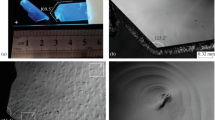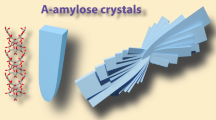Abstract
The effect of L-amino acids, as additives, on the crystal growth and morphology of L-alanine crystals has been studied. The crystal growth of L-alanine is described by the spiral growth mechanism. From examining the growth rate dependence on supersaturation at constant additive concentration, it is concluded that there is no change in the growth mechanism due to the presence of the different additives. L-Alanine crystals were grown both in the absence and in the presence of additives. The crystal morphology was characterized by optical goniometry assigning the different Miller indices to the well-developed crystal faces. The addition of L-amino acids selectively inhibits the development of certain L-alanine crystal faces. L-Alanine crystals grown in the presence of nonpolar amino acids, such as L-leucine, L-phenylalanine, and L-valine, at concentrations as low as 0.20 m (0.3%, w/w) develop the {120} faces, whereas the {010}, {110}, and {210} faces are not developed. The effect of these additives on the morphology of L-alanine is explained at the molecular level based on crystallographic considerations. The molecular structure of a face will determine the availability of sites that favor the adsorption of the additives. The availability of sites and their energy, on a particular crystal face, will determine the extent of adsorption. The growth rate of a crystal face is decreased by the adsorption of the additive. The inhibitory effect of these additives can be explained by a Langmuir isotherm, assuming that the inhibition of the growth rate is proportional to the degree of surface coverage and that the crystal surface is homogeneous with respect to the energy of adsorption sites.
Similar content being viewed by others
REFERENCES
L. Addadi, Z. Berkovitch-Yellin, I. Weissbuch, J. van Mil, L. J. W. Shimon, M. Lahav, and L. Leiserowitz. Growth and dissolution of organic crystals with “tailor-made” inhibitors—Implications in stereochemistry and materials science. Angew. Chem. Int. Ed. Engl. 24:466–485 (1985).
W. A. Gey, E. R. Dalbey, and R. W. Van Dolah. Studies on the linear crystallization of TNT systems. J. Am. Chem. Soc. 78:1803–1810 (1956).
W. J. Dunning, R. W. Jackson, and D. G. Mead. The effect of additives on the rate of advance of steps on sucrose surfaces. In M. R. Kern (ed.), Adsorption et Croissance Cristalline, CNRS, Paris, 1965, pp. 303–316.
R. Boistelle and A. Doussoulin. Spiral growth mechanisms of the (110) faces of octacosane crystals in solution. J. Cryst. Growth 33:335–352 (1976).
S. N. Black, R. J. Davey, and M. Halcrow. The kinetics of crystal growth in the presence of tailor-made additives. J. Cryst. Growth 79:765–774 (1986).
H. J. Simpson and R. E. Marsh. The crystal structure of L-alanine. Acta Cryst. 20:550–555 (1966).
J. Garside. Advances in the characterisation of crystal growth. AIChE Symp. Ser. 80:23–38 (1982).
A. A. Chernov. Formation of crystals in solution. Contemp. Phys. 30:251–276 (1989).
D. Lechuga-Ballesteros and N. Rodríguez-Hornedo. The relation between adsorption of additives and crystal growth rate of {s cL}-alanine. J. Int. Coll. Sci. 157:147–153 (1993).
W. K. Burton, N. Cabrera, and F. C. Frank. The growth of crystals and the equilibrium structure of their surfaces. Phil. Trans. Roy. Soc. A243:299–358 (1951).
R. J. Davey. The effect of impurity adsorption on the kinetics of crystal growth from solution. J. Cryst. Growth 34:109–119 (1976).
G. Bliznakov and E. Z. Kirkova. Der Einflub der Adsorption auf das Kristallwachstum. Z. Phys. Chem. 206:271–280 (1957).
I. Weissbuch, L. Addadi, Z. Berkovitch-Yellin, E. Gati, S. Weinstein, M. Lahav, and L. Leiserowitz. Centrosymmetric crystals for the direct assignment of the absolute configuration of chiral molecules. Application to the α-amino acids by their effect on glycine crystals. J. Am. Chem. Soc. 105:6615–6621 (1983).
M. R. Rosene, M. Özcan, and M. Manes. Application of the Polanyi adsorption potential theory to adsorption from solution on activated carbon. 8. Ideal, nonideal and competitive adsorption of some solids from water solution. J. Phys. Chem. 80:2586–2589 (1976).
E. Piperaki, H. Berndt, and E. Jackwerth. Investigations on the sorption of metal chelates on activated carbon. Anal. Chim. Acta 100:589–596 (1978).
Author information
Authors and Affiliations
Rights and permissions
About this article
Cite this article
Lechuga-Ballesteros, D., Rodriguez-Hornedo, N. Growth and Morphology of L-Alanine Crystals: Influence of Additive Adsorption. Pharm Res 10, 1008–1014 (1993). https://doi.org/10.1023/A:1018962722691
Issue Date:
DOI: https://doi.org/10.1023/A:1018962722691




